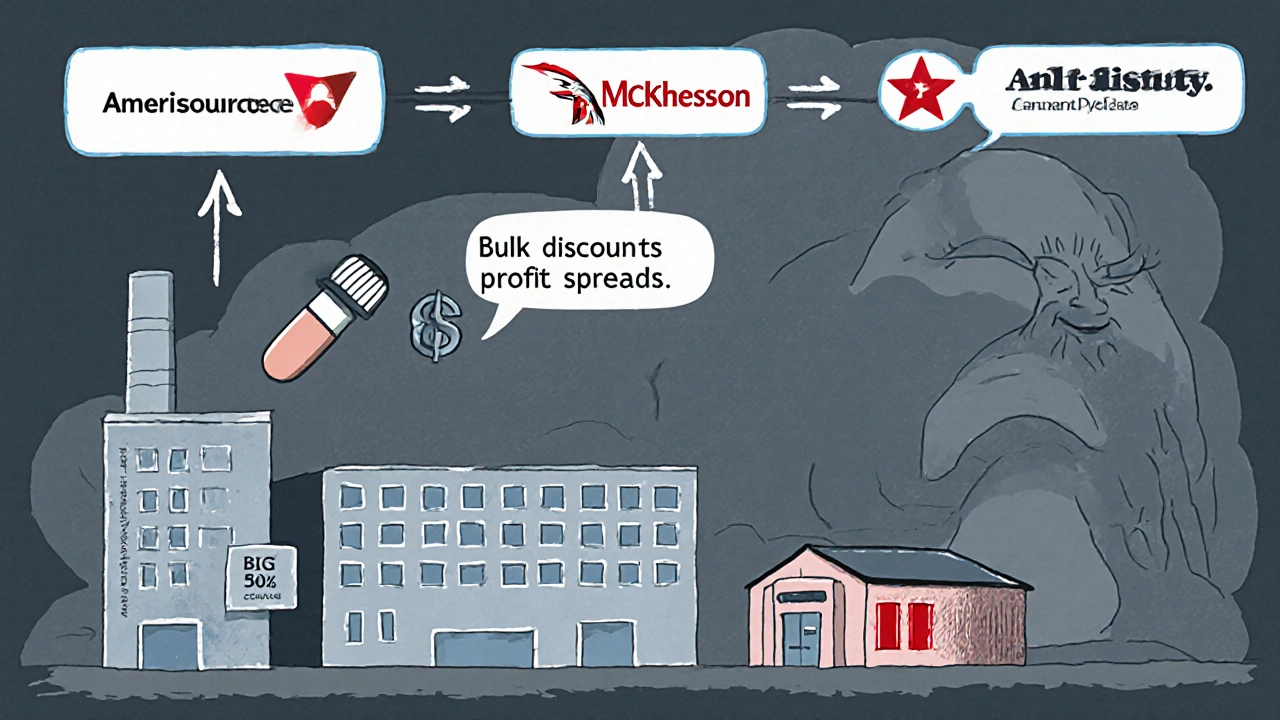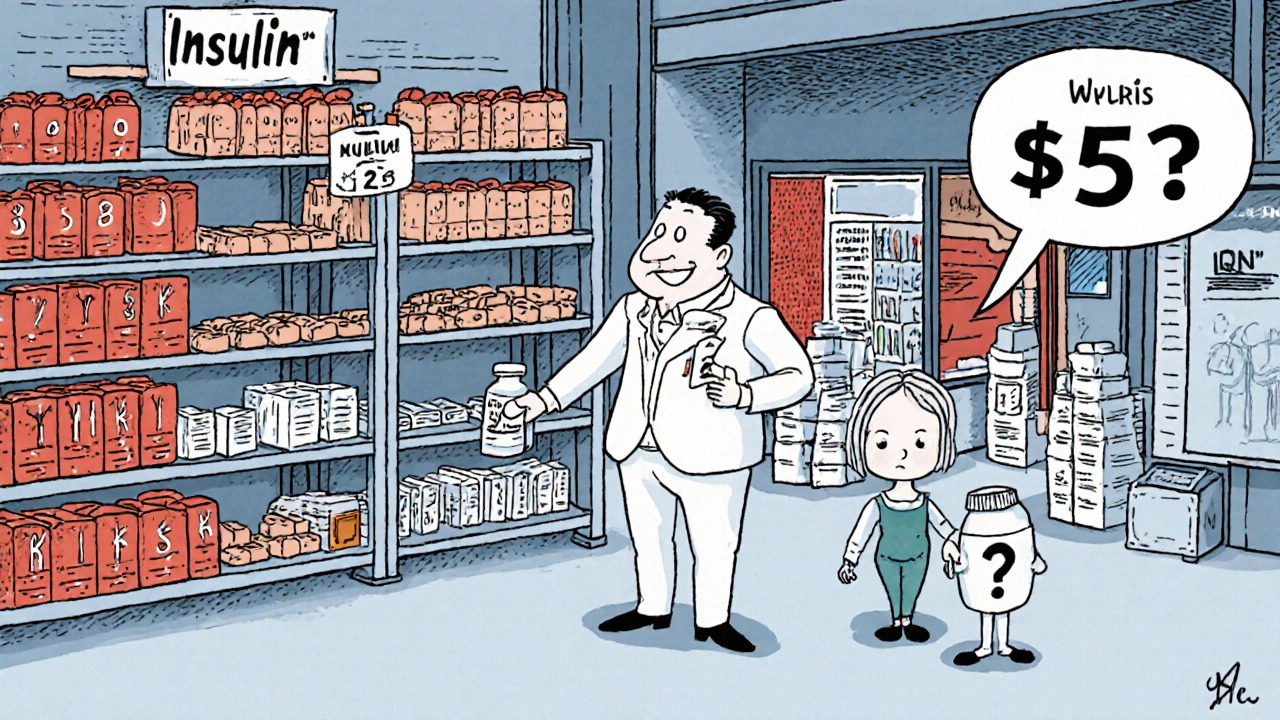Wholesale Economics: How Generic Drug Distribution and Pricing Really Work
 Nov, 13 2025
Nov, 13 2025
When you pick up a prescription for a generic pill at your local pharmacy, you probably don’t think about how it got there. But behind that $5 bottle of lisinopril or metformin is a complex, high-stakes economic system that moves billions of dollars every year-and where the real profits aren’t where most people expect them to be.
The Three-Tier System No One Talks About
The path from a drug manufacturer to your medicine cabinet isn’t direct. It goes through three layers: manufacturers, wholesalers, and pharmacies. This structure was formalized in 1987 by the Prescription Drug Marketing Act, but its economic logic hasn’t changed much since. The big players? AmerisourceBergen, Cardinal Health, and McKesson. Together, they control about 85% of the U.S. generic drug wholesale market. That kind of concentration means they hold serious power-over manufacturers, over pharmacies, and over prices.Why Generics Are the Hidden Goldmine
You’d think branded drugs make the most money. After all, they cost hundreds or even thousands of dollars. But in the wholesale world, generics are the real profit engines. In 2009, generics made up only 9% of the total revenue for the Big Three wholesalers-but they delivered 56% of their gross profits. That’s not a typo. Wholesalers made eleven times more profit per unit on generic drugs than on branded ones: $32 versus $3. Pharmacies made nearly the same: $32 per generic unit versus $3 per branded one. Why? Because generic manufacturers are desperate to get their products onto pharmacy shelves. With no patent protection, they compete on price. To win contracts with big wholesalers, they slash prices aggressively. That leaves wholesalers with huge spreads between what they pay and what they charge pharmacies. It’s not about volume alone-it’s about pricing power.How Wholesalers Actually Make Money
Wholesalers don’t make money by marking up prices wildly. Their net profit margin is shockingly thin-just 0.5%. That’s because they handle massive volumes. A single truckload can carry hundreds of thousands of pills. Profit comes from squeezing every penny out of each transaction through volume discounts, rebates, and logistics efficiency. They use tiered pricing to push pharmacies into buying more. If you order under 100 units, you pay $10 per pill. Order over 100, and it drops to $8. Go over 500, and it’s $7. These aren’t random numbers. They’re engineered to lock in bulk buyers. Shipping costs are baked in too. If a pill costs $10 to make and $2 to ship, the wholesaler won’t sell it for $10. They’ll charge $12-because they can’t afford to lose money on delivery.Cost-Plus vs. Market-Based Pricing: The Two Real Strategies
Wholesalers don’t just guess at prices. They use two main models:- Cost-plus pricing: Add a fixed percentage (usually 20-50%) to the total cost of the drug, including manufacturing, shipping, storage, and handling. Simple. Predictable. But risky if competitors undercut you.
- Market-based pricing: Watch what others charge and match or beat them. This keeps you competitive but can turn into a race to the bottom-especially in crowded generic markets.
Who Makes the Real Money? The Numbers Don’t Lie
Let’s break it down:| Entity | Gross Margin on Branded Drugs | Gross Margin on Generic Drugs |
|---|---|---|
| Manufacturer | 76.3% | 49.8% |
| Wholesaler | Low (single digits) | High (up to 40%+ on gross profit) |
| Pharmacy | 25-30% | 42.7% |

Why This System Is Under Pressure
The generic drug market was in a deflationary spiral from 2021 to 2022. Prices kept dropping as more manufacturers entered the space. But in 2023, everything changed. Shortages of key generic drugs-like those used in ICU care or for chronic conditions-started appearing. When supply drops and demand stays high, prices jump. Wholesalers, sitting on inventory, suddenly had leverage. Some prices doubled or tripled overnight. The Commonwealth Fund says this isn’t just bad luck. It’s a feature of the system. Wholesalers have influence over which drugs get prioritized, which get delayed, and which get labeled “in shortage.” That gives them power to manipulate the market-not by breaking rules, but by playing the game better than anyone else.What Could Change?
Experts like Dr. Neeraj Sood from the USC Schaeffer Center argue that the current system needs more competition. Right now, the Big Three control almost everything. Smaller wholesalers can’t compete on scale. New entrants struggle to get contracts. If more players entered the market, prices might fall. But consolidation isn’t slowing down. Regulators are watching. The government has started asking questions about how list prices are set, how rebates are hidden, and whether wholesalers are contributing to drug shortages. But meaningful reform? That’s still years away.What This Means for You
If you’re a patient, you’re paying for a system designed to maximize profits for intermediaries, not to minimize your costs. A $5 generic pill doesn’t cost $5 to produce. It might cost $0.20. But the path it takes to get to you adds layers of markup-and most of that markup goes to wholesalers and pharmacies, not the makers. If you’re a small pharmacy owner, you’re stuck in the middle. You need generics to stay profitable, but you’re at the mercy of wholesalers who control supply and pricing. If you don’t buy in bulk, you pay more. If you do, you tie up cash in inventory that might sit for months. And if you’re a policymaker? The data is clear: the current model isn’t broken. It’s working exactly as intended-for the people who run it.Why are generic drugs cheaper at some pharmacies than others?
It’s not about the drug-it’s about the supply chain. Pharmacies that buy in bulk directly from wholesalers get better pricing. Chains like Walmart and Costco use their buying power to negotiate lower wholesale rates, then pass savings to customers. Independent pharmacies often pay higher prices because they order smaller quantities. Some also get rebates from PBMs (pharmacy benefit managers), which can lower the final price even further.
Do wholesalers cause drug shortages?
They don’t cause shortages directly, but they influence them. Wholesalers decide which manufacturers to prioritize, which orders to fulfill first, and which drugs to stock. If a generic drug becomes profitable, they’ll stock more. If it’s cheap and plentiful, they might stop carrying it. When a shortage hits, they’re often the first to raise prices-and the last to increase supply. Their inventory decisions directly affect availability.
Can the government fix generic drug pricing?
It can try, but it’s complicated. The government can’t directly control wholesale prices because they’re private business decisions. However, it can increase transparency, require public reporting of prices, and encourage competition by supporting new manufacturers or breaking up monopolies. Medicare and Medicaid already negotiate prices, but those deals don’t always reach private pharmacies. Real change would require restructuring the entire distribution chain.
Why don’t manufacturers just sell directly to pharmacies?
They could, but it’s not practical. Wholesalers handle logistics, storage, billing, and delivery for thousands of pharmacies across the country. A small manufacturer might make 100,000 pills a month. Delivering them to 5,000 pharmacies individually? That’s impossible without a massive infrastructure. Wholesalers act as the middleman that makes scale possible-even if they take a big cut.
Is there a better way to distribute generic drugs?
Yes-but it’s not simple. Some experts suggest regional cooperatives where pharmacies pool orders to get bulk discounts. Others propose direct manufacturer-to-pharmacy models for high-volume generics. A few states are experimenting with public wholesalers to cut out private intermediaries. But all of these face resistance from the current system. Change requires not just policy, but a complete overhaul of how the industry operates.